Wooden fences were originally used as protective structures. With the development of technologies and the emergence of various social classes, their role was gradually reduced to the delimitation of the adjacent territories. Every homeowner tries to give his wood fence an unusual, respectable look, emphasizing his status and well-being.
Advantages and disadvantages of wooden fences
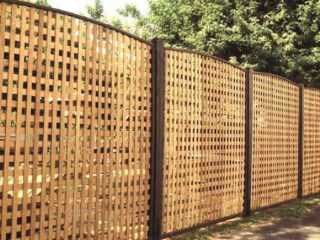
Despite the emergence of modern materials that can be successfully used in the construction of hedges, wooden fences have not lost their popularity. Wooden fences have the following advantages:
- organically fit into almost any surrounding landscape;
- give the territory of the site uniqueness and elegance;
- in harmony with the most modern finishing materials;
- do not heat up under the influence of direct sunlight;
- environmentally friendly;
- easy to repair.
A wooden fence is able to amaze guests with a variety of options. For example, it can be solid or with gaps between the pickets, have a zigzag or wavy shape of the upper edge, and be carved.
A well-assembled wooden fence is much more expensive than a corrugated or mesh fence.
The disadvantages of a wooden fence are much less than advantages. The most significant of them is the need for regular maintenance, without which the service life of the fence is limited.
In general, caring for a wooden fence is reduced to a periodic inspection (once every 2-3 years) to identify and replace damaged parts, as well as to cover its components with fire retardant and antiseptic compounds. Such treatment is carried out once every 5-7 years.
Timely maintenance of the wooden structure will extend its service life up to 20 ... 25 years.
Wooden fences for a private house
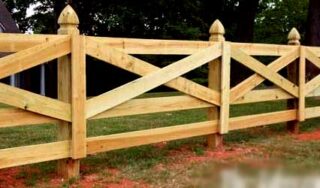
A beautiful wooden fence for a private house helps the owners of the adjoining territories to express their individuality as vividly as possible. In appearance, the designs are very diverse:
- classic style;
- American ranch;
- palisade;
- picket fence (horizontal, vertical, etc.);
- chess.
Combined wooden fences are erected using concrete, stone, metal picket fence or other materials in order to improve operational parameters: reliability, strength, stability. Most often, such materials serve as a foundation or vertical supports for a fence. However, this does not prevent them from performing decorative functions.
Classic wooden fences
They can serve as samples of fences made of boards, assembled as a continuous canvas, which can be vertical or horizontal.
The classic fence is easy to install and does not require a wide range of materials. Steel pipes or wooden beams, which are concreted in the ground, serve as supports during its construction. Logs are mounted between them, to which the boards are attached. With appropriate processing of materials and subsequent decorative finishing, such a fence can last 10-15 years.
American ranch
Fences are similar in appearance to traditional fences widely used by American farmers. In Russia, such fences outline the territories of vegetable gardens or pastures.They will not be able to protect the territory from prying eyes.
Structurally, the fence of the American ranch is a horizontal board fixed on vertical bars. Its distinctive feature is the large gaps between the boards.
The name "Rancho" is often used in the Russian outback to refer to simple low fences with vertically installed boards (pickets).
Palisade
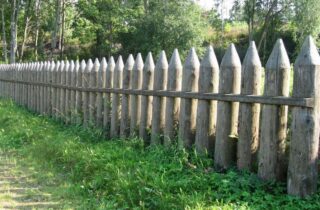
The palisade is a vertically oriented canvas, assembled from tightly pressed to each other, pointed at the top of the stakes. Such a fence primarily performs a protective function, since it is not easy to climb over it.
The palisade is mounted on vertical and horizontal wooden logs. The pillars driven into the ground act as supports, and for greater stability they are driven in at least 1/3 of the length. Vertically installed logs are interconnected by horizontally located logs, to which the stakes are tied with a rope. The service life of the picket fence is not long, since the fence deprived of a solid foundation looses and sags over time. For this reason, the palisade is rare nowadays.
Lattice
A wooden fence does not have to be strictly vertical or horizontal. It can be assembled from prefabricated diamond mesh sections. They are based on frames made of timber, for internal filling, slats mounted at an angle of 45 ° are used. The lattice structure of the frames is practically not used as an independent fence, but rather serves as a decorative design of the latter.
Most often, an openwork lattice fence is used to highlight individual zones of a garden and park landscape.
Fence
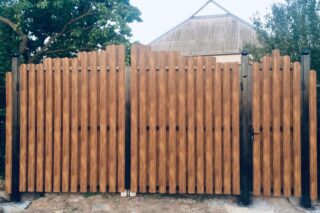
Picket fence is one of the most popular rustic style fences. They use it as an independent type of fence or as a decoration, for example, a veranda or balcony. A prerequisite for the use of a picket fence is the treatment of its lamellas with an antiseptic, which protects them from mold, fungus and pests.
There are several types of picket fence:
- The horizontal picket fence is structurally simple, harmonious and goes well with most modern buildings. There are several varieties of it. Each is able to give the local area a characteristic appearance only for him.
- The vertical picket fence seems to be more versatile. It is decorative and at the same time creates a certain degree of privacy. The construction of this fence is based on metal supports or on a stone base. When assembling, it is customary to leave small gaps between the lamellas, which promote air circulation.
- Chess is a complicated version, which is a combination of classics, palisade and picket fence. It is used when arranging the landscape of adjoining territories. Picket lamellas can be mounted with gaps, or they can look like a "blank" fence. At the same time, the latter option will allow you to close the territory of the site from prying eyes.
- Herringbone is a variant of a horizontal picket fence, which is used when you need to build a solid fence that protects the area from prying eyes, exhaust gases, intrusive sounds and dust. Most often, such fences are mounted when the adjacent territory is located directly next to noisy streets or roads with heavy traffic.
Any wooden fence is able to mark the boundaries of the site and protect the area from prying eyes and unexpected guests. A competently mounted fence will complement the existing landscape and give it the necessary decorative effect. The main thing is to choose the type of fence, the materials of which will be in harmony with the buildings already on the site in color, texture and other elements of landscape design.
Construction features
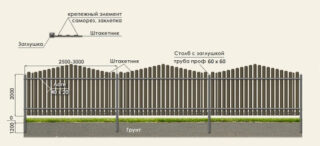
For the construction of a wooden fence, wood is usually used from coniferous or broad-leaved trees (larch, cedar, pine, spruce). In this case, the species of wood is not so important as its quality. The main thing is not to forget to treat the wood with antiseptic and fire retardant compounds.
A beautiful fence for a country house made of wood is erected according to well-known technologies, which are based on three components:
- support pillars;
- spans and logs (crossbars);
- entrance opening.
A special visor, which is installed at the request of the owner, will help protect the upper part of the fence from the effects of rain and snow. Attach it to the slats mounted on the upper edge of the fence. At the same time, the appearance of the fence will become even more individual.
Special treatment and painting of the fence reliably protects from bad weather and insects. Ordinary drying oil is also suitable as a protective coating, although more expensive means can be used. After the protective layer has dried, they begin to paint the fence, using special paints for wood. The combination of drying oil and paints will provide reliable protection of the fence from the sun and water.
You need to paint a wooden fence regularly - at least once every two to three years.
To reliably protect the bottom of the hedge, you will need to remove all excess grass, the presence of which contributes to the appearance of high humidity. Then you need to pour a thin layer of gravel along the fence. This will help prevent moisture build-up in the immediate vicinity of the fence and prevent early wood decay.








